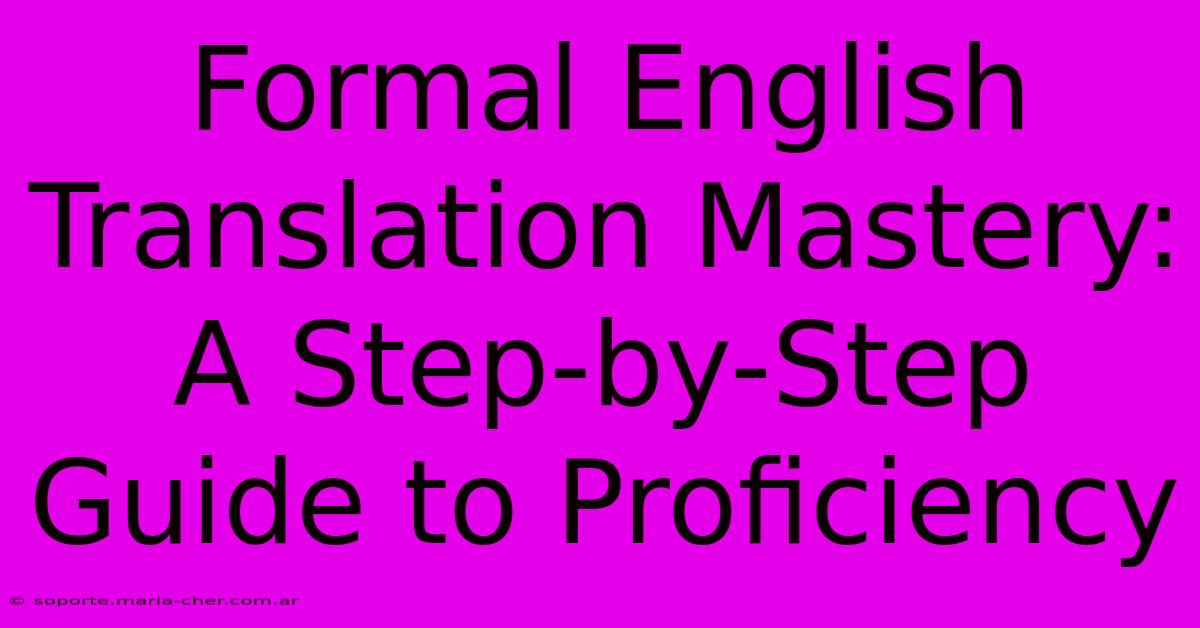Formal English Translation Mastery: A Step-by-Step Guide To Proficiency

Table of Contents
Formal English Translation Mastery: A Step-by-Step Guide to Proficiency
Translation isn't just about swapping words; it's about conveying meaning, nuance, and cultural context accurately. Mastering formal English translation demands precision, attention to detail, and a deep understanding of both the source and target languages. This guide provides a step-by-step approach to achieving proficiency.
Understanding the Nuances of Formal English
Formal English differs significantly from informal English in vocabulary, sentence structure, and tone. Before diving into translation, you must grasp these distinctions.
Key Characteristics of Formal English:
- Vocabulary: Avoid colloquialisms, slang, contractions (e.g., "can't," "won't"), and idioms. Opt for precise, sophisticated vocabulary.
- Sentence Structure: Employ complex sentence structures, utilizing subordinate clauses and participial phrases to convey detailed information effectively. Avoid short, choppy sentences.
- Tone: Maintain a neutral, objective, and respectful tone. Avoid emotional language or subjective opinions.
- Grammar: Adhere strictly to grammatical rules. Accuracy is paramount.
- Style: Follow established conventions for formal writing, including appropriate punctuation and formatting.
The Step-by-Step Translation Process
Effective formal English translation is a multi-stage process:
1. Deep Understanding of the Source Text:
- Comprehend the context: Don't just translate individual words; understand the overall message, purpose, and intended audience of the source text. Research the background information if needed.
- Identify key terms and concepts: Pay close attention to technical terms, legal jargon, or culturally specific references. Look up unfamiliar words and phrases.
- Analyze sentence structure: Break down complex sentences into simpler components to understand the grammatical relationships between words and phrases.
2. Choosing the Right Equivalents:
- Avoid literal translations: Literal translations often fail to capture the true meaning or sound natural in the target language. Focus on conveying the meaning rather than simply translating word-for-word.
- Consider cultural context: Words and phrases can have different cultural connotations. Choose equivalents that resonate with the target audience and maintain the intended tone.
- Utilize dictionaries and thesauruses: Refer to reputable dictionaries and thesauruses to find the most appropriate words and phrases. Don't rely solely on online translators.
3. Crafting the Target Text:
- Maintain consistency: Ensure consistency in terminology, style, and tone throughout the translated text.
- Review and revise: Thoroughly review your translation for accuracy, clarity, and style. Seek feedback from others if possible.
- Proofread meticulously: Pay attention to grammar, spelling, punctuation, and formatting. Errors can undermine the credibility of your work.
4. Refining and Polishing:
- Seek feedback: Have a colleague or editor review your translation for accuracy and fluency.
- Iterative process: Translation is often an iterative process. Be prepared to revise and refine your work multiple times.
- Style guide adherence: If working with a specific style guide (e.g., Chicago Manual of Style), ensure your translation adheres to its guidelines.
Essential Resources for Formal English Translation
- High-quality dictionaries and thesauruses: Invest in reputable dictionaries and thesauruses for both your source and target languages.
- Translation software (with caution): Translation software can be helpful for preliminary work, but it shouldn't replace human judgment and expertise. Always review and edit the output carefully.
- Style guides: Familiarize yourself with relevant style guides to maintain consistency and professionalism.
- Professional development: Consider taking courses or workshops to improve your translation skills.
Mastering Formal English Translation: A Continuous Journey
Proficiency in formal English translation is not a destination but a continuous journey. By consistently applying these steps, dedicating yourself to continuous learning, and embracing the challenges of accurate and nuanced communication, you'll steadily enhance your skills and become a master of your craft. Remember, precision, accuracy, and cultural sensitivity are the cornerstones of successful formal English translation.

Thank you for visiting our website wich cover about Formal English Translation Mastery: A Step-by-Step Guide To Proficiency. We hope the information provided has been useful to you. Feel free to contact us if you have any questions or need further assistance. See you next time and dont miss to bookmark.
Featured Posts
-
Express Gratitude Like A Pro Your Foolproof Formula For Thank You Emails
Feb 09, 2025
-
Ring Rhapsody Jewellers Vs Jewelers A Spelling Showstopper With A Sparkling Twist
Feb 09, 2025
-
Formal English Translation Mastery A Step By Step Guide To Proficiency
Feb 09, 2025
-
Transform Your Communication With Our Unrivaled Formal Text Generator
Feb 09, 2025
-
Combined Filets And Fillets Titles
Feb 09, 2025
